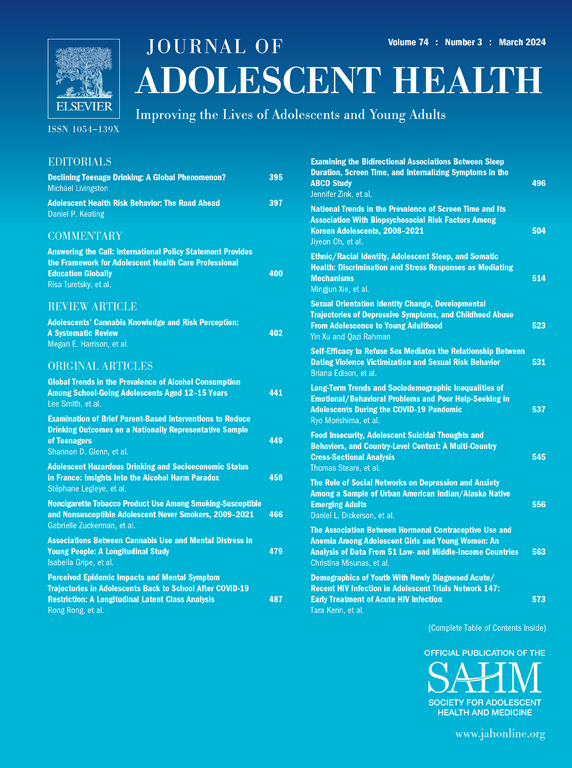Trends and Sociodemographic Differences in Tobacco/Nicotine Transitions Among U.S. Adolescents and Young Adults Using e-cigarettes, 2014–2023
IF 4.5
2区 医学
Q1 PEDIATRICS
引用次数: 0
Abstract
Purpose
E-cigarette use among adolescents and young adults (AYAs) remains prevalent in the United States and is linked with combustible tobacco product use. This study examines sociodemographic differences (i.e., sex, age, sexual identity, transgender identity, race, ethnicity, and income) in transitions from e-cigarette use to other forms of tobacco use among AYAs from 2014 to 2023.
Methods
AYAs aged 14–25 years from the nationally representative Population Assessment of Tobacco and Health study waves 2–7 (2014/15–2022/23) were used to examine transitions in e-cigarette and combustible tobacco use over 1-to-2-year periods (n = 7,523). Using multinomial logistic regression models, we examined associations of sociodemographic characteristics and wave with e-cigarette and combustible tobacco transitions.
Results
Maintaining e-cigarette use only (21.2% in 2014/15–49.2% in 2022/23) and transitioning from e-cigarette and combustible use (i.e., dual use) to e-cigarettes only (7.6% in 2014/15–29.7% in 2022/23) increased over time. Simultaneously, transitioning from e-cigarettes to dual use (18.2% in 2014/15–17.9% in 2022/23) and maintaining dual use remained steady. Bisexual individuals were more likely to transition from e-cigarette use only to dual use (adjusted relative risk ratio = 2.07; 95% confidence interval = 1.44, 2.99) and maintain dual use (adjusted relative risk ratio = 2.01; 95% confidence interval = 1.43, 2.84), compared to heterosexual individuals. Female, Hispanic, and Black individuals were less likely to transition to dual use or maintain dual use compared to male, non-Hispanic, and White individuals, respectively.
Discussion
Findings identify important sociodemographic groups at greater risk of transitions to combustible tobacco use that warrant attention in future research and prevention strategies to reduce health disparities.
2014-2023年美国青少年和年轻人使用电子烟中烟草/尼古丁过渡的趋势和社会人口统计学差异
目的:电子烟在青少年和年轻人(AYAs)中的使用在美国仍然很普遍,并且与可燃烟草产品的使用有关。本研究调查了2014年至2023年美国青少年从使用电子烟过渡到其他形式烟草使用的社会人口统计学差异(即性别、年龄、性别认同、跨性别认同、种族、民族和收入)。方法:使用来自全国代表性烟草与健康人口评估研究第2-7期(2014/15-2022/23)的14-25岁的青少年(n = 7523)来检查1- 2年期间电子烟和可燃烟草使用的转变。使用多项逻辑回归模型,我们研究了社会人口学特征和波动与电子烟和可燃烟草过渡的关系。结果:随着时间的推移,仅维持电子烟使用(2014/15- 2022/23年为21.2%)和从电子烟和可燃物使用(即双重使用)过渡到仅使用电子烟(2014/15- 2022/23年为7.6% -29.7%)的比例有所增加。同时,从电子烟向双重用途的过渡(2014/15年为18.2%,2022/23年为17.9%)和保持双重用途保持稳定。双性恋者更有可能从只使用电子烟转变为双重使用(调整后的相对风险比= 2.07;95%可信区间= 1.44,2.99),维持双重使用(调整后的相对风险比= 2.01;95%可信区间= 1.43,2.84)。与男性、非西班牙裔和白人个体相比,女性、西班牙裔和黑人个体向双重用途过渡或维持双重用途的可能性较小。讨论:研究结果确定了向可燃烟草使用过渡风险较大的重要社会人口统计学群体,值得在未来的研究和预防战略中予以关注,以减少健康差距。
本文章由计算机程序翻译,如有差异,请以英文原文为准。
求助全文
约1分钟内获得全文
求助全文
来源期刊

Journal of Adolescent Health
医学-公共卫生、环境卫生与职业卫生
CiteScore
10.40
自引率
3.90%
发文量
526
审稿时长
46 days
期刊介绍:
The Journal of Adolescent Health is a scientific publication dedicated to enhancing the health and well-being of adolescents and young adults. Our Journal covers a broad range of research topics, spanning from the basic biological and behavioral sciences to public health and policy. We welcome a variety of contributions, including original research papers, concise reports, literature reviews, clinical case reports, opinion pieces, and letters to the editor. We encourage professionals from diverse disciplines such as Anthropology, Education, Ethics, Global Health, Health Services Research, Law, Medicine, Mental and Behavioral Health, Nursing, Nutrition, Psychology, Public Health and Policy, Social Work, Sociology, and Youth Development to share their expertise and contribute to our mission of promoting adolescent health. Moreover, we value the voices of young individuals, family and community members, and healthcare professionals, and encourage them to submit poetry, personal narratives, images, and other creative works that provide unique insights into the experiences of adolescents and young adults. By combining scientific peer-reviewed research with creative expressions, our Journal aims to create a comprehensive understanding of the challenges and opportunities in adolescent and young adult health.
 求助内容:
求助内容: 应助结果提醒方式:
应助结果提醒方式:


